Use the Art Worksheet to Create a Blank Pivottable on a New Worksheet Named Pivottable
A PivotTable is a powerful tool to calculate, summarize, and clarify data that lets you encounter comparisons, patterns, and trends in your data.
PivotTables work a little bit differently depending on what platform you are using to run Excel.

Create a PivotTable in Excel for Windows
-
Select the cells you want to create a PivotTable from.
Annotation: Your information should be organized in columns with a single header row.
-
SelectInsert >PivotTable.
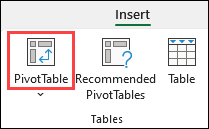
-
This will create a PivotTable based on an existing table or range.
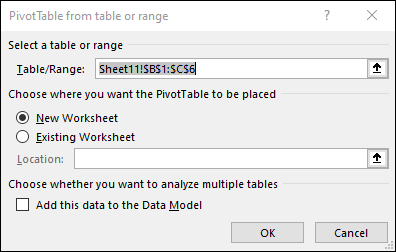
Note:Selecting Add together this data to the Data Model will add the tabular array or range existence used for this PivotTable into the workbook's Data Model. Learn more than.
-
Cull where you want the PivotTable report to be placed. SelectNew Worksheet to place the PivotTable in a new worksheet orExisting Worksheet and select where yous desire the new PivotTable to appear.
-
Click OK
PivotTables from other sources
Past clicking the down pointer on the button, yous can select from other possible sources for your PivotTable. In add-on to using an existing table or range, at that place are three other sources you can select from to populate your PivotTable.
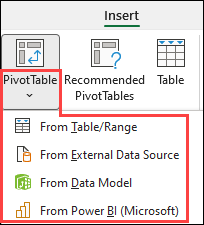
Note:Depending on your system'south IT settings you might meet your arrangement'due south name included in the button. For example, "From Power BI (Microsoft)"
From External Data Source
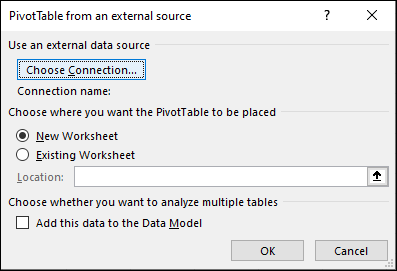
From Information Model
Utilise this option if your workbook contains a Data Model, and you want to create a PivotTable from multiple Tables, enhance the PivotTable with custom measures, or are working with very large datasets.
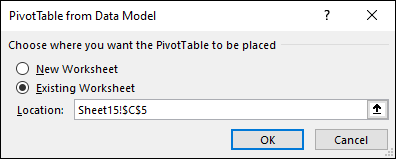
From Power BI
Use this option if your arrangement uses Power BI and you lot want to notice and connect to endorsed cloud datasets you have admission to.
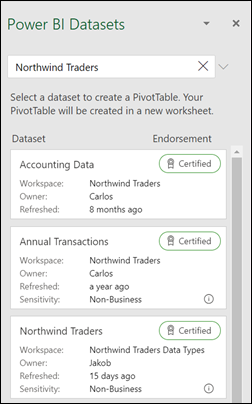
Building out your PivotTable
-
To add together a field to your PivotTable, select the field proper noun checkbox in thePivotTables Fields pane.
Note:Selected fields are added to their default areas: non-numeric fields are added toRows, appointment and time hierarchies are added toColumns, and numeric fields are added toValues.
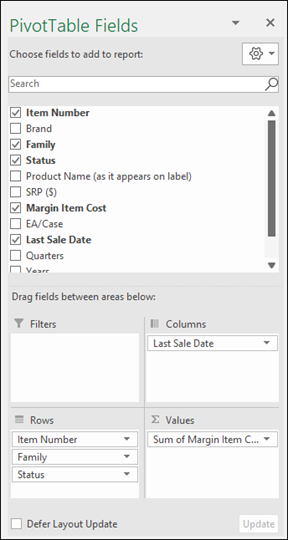
-
To move a field from ane expanse to some other, drag the field to the target area.
Summarize Values Past
By default, PivotTable fields that are placed in the Values expanse volition be displayed as a SUM. If Excel interprets your information as text, it will be displayed as a COUNT. This is why information technology's so important to make certain you don't mix information types for value fields. You can modify the default calculation by first clicking on the pointer to the right of the field proper noun, then select the Value Field Settings option.
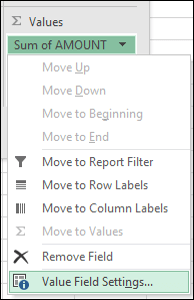
Next, change the calculation in the Summarize Values By section. Note that when you modify the adding method, Excel will automatically suspend it in the Custom Name department, similar "Sum of FieldName", but you tin can change it. If you click the Number Format push button, y'all can change the number format for the entire field.
Tip:Since the changing the calculation in the Summarize Values Past section volition change the PivotTable field name, it'south best not to rename your PivotTable fields until yous're done setting up your PivotTable. One trick is to use Find & Replace (Ctrl+H) >Find what > "Sum of", and so Supervene upon with > leave blank to replace everything at once instead of manually retyping.
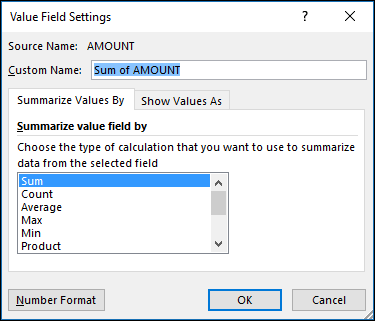
Show Values Every bit
Instead of using a adding to summarize the data, y'all tin also display it every bit a percent of a field. In the following example, we changed our household expense amounts to display as a % of Grand Total instead of the sum of the values.
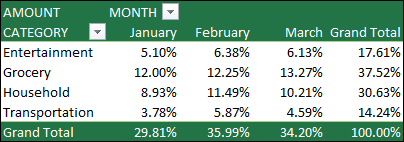
Once you've opened the Value Field Setting dialog, you can make your selections from the Show Values Every bit tab.
Display a value as both a calculation and per centum.
Simply elevate the item into the Values section twice, and so prepare the Summarize Values Past and Show Values As options for each ane.

Earlier yous become started:
-
Your data should be organized in a tabular format, and non have whatever blank rows or columns. Ideally, you can use an Excel tabular array similar in our example above.
-
Tables are a groovy PivotTable information source, because rows added to a tabular array are automatically included in the PivotTable when yous refresh the data, and any new columns will exist included in the PivotTable Fields List. Otherwise, you need to either Change the source data for a PivotTable, or use a dynamic named range formula.
-
Data types in columns should be the same. For instance, you shouldn't mix dates and text in the same cavalcade.
-
PivotTables piece of work on a snapshot of your data, called the enshroud, then your bodily information doesn't get altered in any manner.
If you have limited feel with PivotTables, or are not certain how to get started, a Recommended PivotTable is a skillful option. When y'all employ this feature, Excel determines a meaningful layout by matching the data with the most suitable areas in the PivotTable. This helps give you a starting point for boosted experimentation. Later a recommended PivotTable is created, you can explore different orientations and rearrange fields to reach your specific results.
You can too download our interactive Make your kickoff PivotTable tutorial.
ane. Click a cell in the source data or table range.
2. Go to Insert > Recommended PivotTable.

3. Excel analyzes your data and presents you with several options, like in this example using the household expense data.

iv. Select the PivotTable that looks all-time to you lot and press OK. Excel will create a PivotTable on a new sheet, and brandish the PivotTable Fields List.
ane. Click a cell in the source information or table range.
2. Go to Insert > PivotTable.
If you're using Excel for Mac 2011 and earlier, the PivotTable push is on the Data tab in the Analysis grouping.

3. Excel will display the Create PivotTable dialog with your range or tabular array name selected. In this example, we're using a tabular array chosen "tbl_HouseholdExpenses".
4. In the Choose where you want the PivotTable study to be placed section, select New Worksheet, or Existing Worksheet. For Existing Worksheet, select the cell where you lot want the PivotTable placed.
5. Click OK, and Excel will create a blank PivotTable, and display the PivotTable Fields list.
PivotTable Fields list
In the Field Proper noun area at the top, select the cheque box for any field you want to add to your PivotTable. By default, non-numeric fields are added to the Row area, date and time fields are added to the Column area, and numeric fields are added to the Values area. You tin also manually elevate-and-drop any available item into any of the PivotTable fields, or if you no longer want an detail in your PivotTable, simply drag it out of the Fields list or uncheck it. Beingness able to rearrange Field items is 1 of the PivotTable features that makes it so piece of cake to rapidly change its appearance.
PivotTable Fields listing
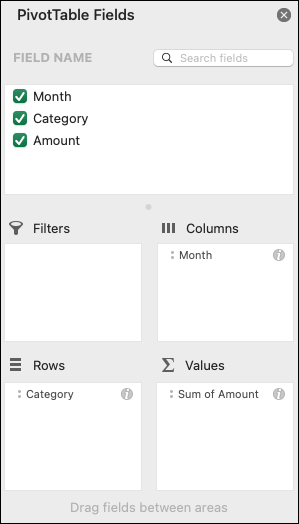
-
Summarize by
Past default, PivotTable fields that are placed in the Values area will exist displayed equally a SUM. If Excel interprets your data equally text, information technology will be displayed as a COUNT. This is why it's and then important to brand sure y'all don't mix data types for value fields. You can change the default calculation past get-go clicking on the arrow to the right of the field proper name, then select the Field Settings option.
Adjacent, change the calculation in the Summarize past section. Note that when y'all modify the calculation method, Excel volition automatically append it in the Custom Name department, like "Sum of FieldName", but you can change it. If y'all click the Number... button, you tin alter the number format for the unabridged field.
Tip:Since the changing the calculation in the Summarize by section volition change the PivotTable field name, it'southward all-time not to rename your PivotTable fields until you're done setting upwardly your PivotTable. One trick is to click Replace (on the Edit bill of fare) >Find what > "Sum of", then Replace with > leave blank to replace everything at one time instead of manually retyping.
-
Show information equally
Instead of using a calculation to summarize the data, you can also display it equally a percentage of a field. In the following case, we changed our household expense amounts to display as a % of Grand Total instead of the sum of the values.

One time you've opened the Field Settings dialog, you can brand your selections from the Show data every bit tab.
-
Display a value every bit both a calculation and percentage.
Merely elevate the item into the Values section twice, correct-click the value and select Field Settings, then set the Summarize past and Show data as options for each one.
If yous add new data to your PivotTable data source, any PivotTables that were built on that data source demand to exist refreshed. To refresh just ane PivotTable yous can right-click anywhere in the PivotTable range, then select Refresh. If you lot have multiple PivotTables, beginning select any cell in any PivotTable, and so on the Ribbon go to PivotTable Analyze > click the arrow under the Refresh button and select Refresh All.
If you lot created a PivotTable and determine yous no longer desire information technology, y'all can only select the unabridged PivotTable range, and so printing Delete. It won't accept any affect on other data or PivotTables or charts effectually it. If your PivotTable is on a separate canvas that has no other data you want to continue, deleting that sheet is a fast style to remove the PivotTable.

-
Select a tabular array or range of data in your sheet and select Insert > PivotTable to open the Insert PivotTable pane.
-
You can either manually create your ain PivotTable or choose a recommended PivotTable to be created for you lot. Do 1 of the following:
-
On the Create your own PivotTable card, select either New canvass or Existing sheet to cull the destination of the PivotTable.
-
On a recommended PivotTable, select either New sheet or Existing sheetto choose the destination of the PivotTable.
Note:Recommended PivotTables are only bachelor to Microsoft 365 subscribers.
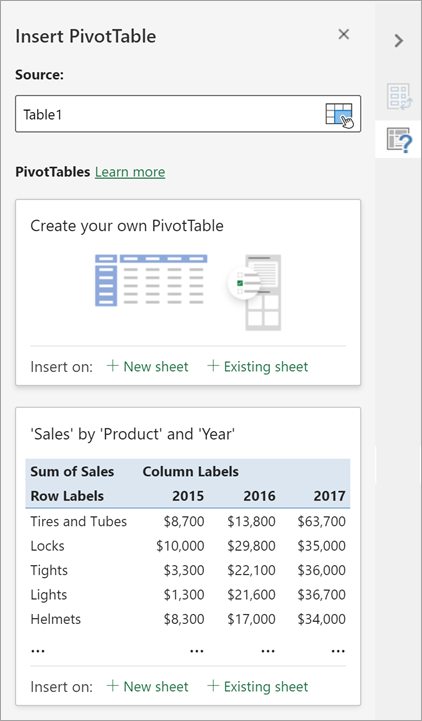
You tin can change the Source for the PivotTable data as you are creating it.
-
In the Insert PivotTable pane, select the text box under Source. While changing the Source, cards in the pane won't exist bachelor.
-
Make a pick of data on the grid or enter a range in the text box.
-
Press Enter on your keyboard or the push button to ostend your selection. The pane will update with new recommended PivotTables based on the new source of data.

In the PivotTable Fields pane, select the check box for any field you lot desire to add to your PivotTable.
By default, non-numeric fields are added to the Rows surface area, date and fourth dimension fields are added to the Columns area, and numeric fields are added to the Values area.
You can as well manually drag-and-drop any available particular into whatever of the PivotTable fields, or if you no longer want an item in your PivotTable, elevate it out from the list or uncheck information technology.
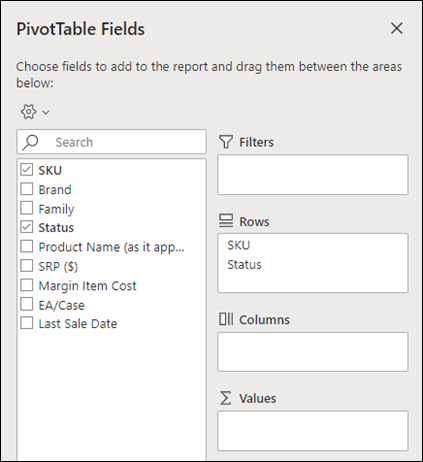
Summarize Values Past
By default, PivotTable fields in the Values area will be displayed equally a SUM. If Excel interprets your data every bit text, it will exist displayed every bit a COUNT. This is why it's and then important to make certain you don't mix information types for value fields.
Modify the default calculation by correct clicking on any value in the row and selecting the Summarize Values Past pick.
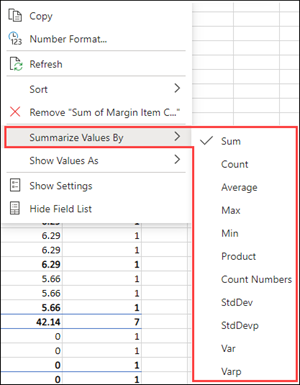
Bear witness Values As
Instead of using a calculation to summarize the data, you lot can also display it every bit a percentage of a field. In the post-obit example, we inverse our household expense amounts to display as a % of Yard Total instead of the sum of the values.

Right click on whatsoever value in the column yous'd like to bear witness the value for. Select Testify Values As in the menu. A list of available values volition display.
Make your choice from the list.
To prove every bit a % of Parent Full, hover over that detail in the list and select the parent field y'all want to utilise as the ground of the adding.
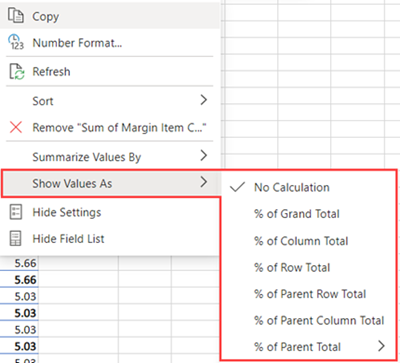
If you add new data to your PivotTable data source, any PivotTables congenital on that information source will need to be refreshed. Right-click anywhere in the PivotTable range, then select Refresh.
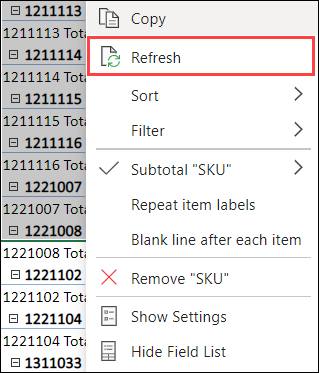
If you created a PivotTable and decide you no longer want it, select the entire PivotTable range and press Delete. It won't have whatever consequence on other data or PivotTables or charts around it. If your PivotTable is on a separate sheet which has no other data you want to keep, deleting the sail is a fast way to remove the PivotTable.
Need more help?
You tin can always enquire an expert in the Excel Tech Community or become support in the Answers community.
PivotTable Recommendations are a part of the connected experience in Part, and analyzes your data with artificial intelligence services. If you cull to opt out of the connected feel in Office, your data will not be sent to the artificial intelligence service, and you lot will non exist able to use PivotTable Recommendations. Read the Microsoft privacy statement for more details.
Related manufactures
Create a PivotChart
Employ slicers to filter PivotTable data
Create a PivotTable timeline to filter dates
Create a PivotTable with the Data Model to analyze data in multiple tables
Create a PivotTable connected to Power BI Datasets
Use the Field List to arrange fields in a PivotTable
Change the source data for a PivotTable
Calculate values in a PivotTable
Delete a PivotTable
Source: https://support.microsoft.com/en-us/office/create-a-pivottable-to-analyze-worksheet-data-a9a84538-bfe9-40a9-a8e9-f99134456576
0 Response to "Use the Art Worksheet to Create a Blank Pivottable on a New Worksheet Named Pivottable"
Postar um comentário